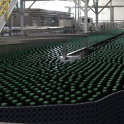|
So I just went and got a new hydrometer, pulled a sample and went to check... 1.000 ... What? Apparently they sold me a hydrometer for distilled spirits only. To be fair, the guy working today was pretty new.
|
|
|
|

|
| # ? May 31, 2024 09:45 |
|
Check it with tap water.
|
|
|
|
The garbage-cheap refractometers on amazon are pretty okay. They get all messed up by particulates, but vacuum filtering a few drops of wort isn't all that onerous. Also, they don't immediately explode if you look at them funny.
|
|
|
|
Glottis posted:Check it with tap water. I did, its accurate. The instruction sheet inside says "For distilled spirits only. Cannot be used with beer, wine, or any other fermented beverage."
|
|
|
|
Scarf posted:I did, its accurate. The instruction sheet inside says "For distilled spirits only. Cannot be used with beer, wine, or any other fermented beverage." After getting that sorted out and getting an actual hydrometer for beer... FG is at 1.010, which is more attenuated than I had anticipated. All the calculations had me at 1.017... but hey, I'm not gonna be bent out of shape by a bit more ABV, especially since this is a party beer. Now it's cold-crashin' time!
|
|
|
|
Just ordered my Easybrew from Braumarkt with that sweet 80 Euro discount Funny enough the discount is A.) only shown on the Dutch version of the store and B.) only applies to that specific SKU, which is unlisted on the English/German language versions of the site (the old model is still showing there).
|
|
|
|
|
Weird drunkposting, but I'm coming to a realization tonight: A lot of my beers (and fellow homebrewer beers) that have have off flavors is just wild yeast infections. I found some commercial beers my brother brought me from about a year ago and they're all gushy with telltales from refermentation/wild yeast. I went through a batch of bad beers some years ago (and one like 2 months ago) that were nothing more than wild yeast infections and I misinterpreted them as process or material issues and that just wasn't the case. Even commercial beers in very good near-sterile environments have this issue. Drink fresh, I guess.
|
|
|
|
Commercial beers are not immune, but they should have sanitation processes in place to avoid it. Anything that's been barrel aged is going to have a higher rate of issues, but regular beer should very rarely if ever have that problem. Any infection, LAB or yeast, comes down to sanitation and process. Commercial shops should hopefully have good quality for cleaning routines, but not everyone does what they need to do. In some ways it's easier to clean on a homebrew scale, but in some ways it's a whole lot more difficult. Plastics, grommets, o-rings, disconnects, siphons, and everything that touches on the cold side needs to be well cleaned and sanitized. It's easier because it's smaller, but it still takes a lot of effort and care. Even when you think you're doing it, you might not be and find something in a valve or somewhere you've been missing. But yeasts, LAB, and a whole lot of other things are everywhere, so it's a never ending fight. Basically, just because you're a commercial brewery doesn't mean you're doing a good job cleaning or otherwise. But you should do if you're wanting to continue with your business, so high standards are a good thing to have.
|
|
|
|
Jhet posted:but regular beer should very rarely if ever have that problem. Any infection, LAB or yeast, comes down to sanitation and process. This. If you're continually having this problem, list out your steps for us and we'll figure it out. I've NEVER had anything resembling an infection and I don't really go overboard cleaning (at least I don't think so).
|
|
|
|
I'm not really having a recurring problem, I was just waxing about things I've seen in other beers - namely a friend of mine who had probably a dozen beers in a row with a telltale phenolic character of a wild "bad" yeast that just hosed up his brewing for a while. Whatever was getting into his beer had this sort of specific chlorophenol thing going on. Because it tasted so chemically, we chased all sorts of production issues around his brewday and it ultimately ended up probably being dumb poo poo like dried up airlocks or something like that. I had one recently that was the result of my souring vessel/fermenter being "open air" for some amount of time due to a hardware issue. My only other issues seems to be if I'm aging a beer. I made a 6% chocolate stout last year that I let sit in the fermenter for over a month, proper diacetyl rest, all that, terminal FG stable. I bottled it and got massive freakish bottle bombs because I either got a secondary yeast infection in the bottling process, or that yeast woke up for some reason and went back to work. Same issue with Lager I did back in January. Long fermentation, stable, lagering rest, proper priming, etc. When I was first drinking it back in April, it was great, but it's getting more and more gushy as it sits. These aren't like HUGE deals for me because I keg 90% of my beer, and NORMALLY when I bottle, I let it condition for 2-3 weeks and cold crash/keep cold from there on.
|
|
|
|
If I'm aging a beer for a while, I get it off the yeast as soon as its hit FG and do the aging in the keg. But yeah, bottling is going to introduce a whole ton of extra chances for infection.
|
|
|
|
Jhet posted:Commercial beers are not immune, but they should have sanitation processes in place to avoid it. Anything that's been barrel aged is going to have a higher rate of issues, but regular beer should very rarely if ever have that problem. Any infection, LAB or yeast, comes down to sanitation and process. Commercial shops should hopefully have good quality for cleaning routines, but not everyone does what they need to do. In some ways it's easier to clean on a homebrew scale, but in some ways it's a whole lot more difficult. Plastics, grommets, o-rings, disconnects, siphons, and everything that touches on the cold side needs to be well cleaned and sanitized. It's easier because it's smaller, but it still takes a lot of effort and care. Even when you think you're doing it, you might not be and find something in a valve or somewhere you've been missing. But yeasts, LAB, and a whole lot of other things are everywhere, so it's a never ending fight. A lot of people assume that commercial is cleaner than homebrewing. In almost all cases, yes, but only because homebrewers donít have access to the level of sani/caustic we do in the brewery. That being said, wild yeast is excruciatingly common when youíre below 10-15k bbl/year or even 50k bbl/year depending on the packaging line. The poo poo Iíve seen from plating and screening packaged goods is hilarious.
|
|
|
|
gamera009 posted:A lot of people assume that commercial is cleaner than homebrewing. In almost all cases, yes, but only because homebrewers donít have access to the level of sani/caustic we do in the brewery. That being said, wild yeast is excruciatingly common when youíre below 10-15k bbl/year or even 50k bbl/year depending on the packaging line. The poo poo Iíve seen from plating and screening packaged goods is hilarious. Oh, definitely it is. Commercially you'll hopefully have a good CIP process in place, and it's a never ending fight of course. It's all those connections and pumps and valves that get everyone in trouble. Yeast is everywhere, long live the yeast. Usually it's not even going to be a problem because it will have been out competed by the pitched yeast, but diastaticus strains aside, it's going to hopefully get caught. Commercial beers by and large are not meant to be stored for 2+ years either, so there's that. Also, I can't just hose down everything inside and out without getting into a lot of trouble with my wife. The part I don't understand about the QA process, is acceptable cell counts in the finished products. I keep hemming and hawing about just doing the Siebel Brewing Microbiology course, but it's $4k for about 2 weeks of course and they only have it in Montreal, not in Chicago. There's a lot of topics that I'd want to cover there, but that's not in the budget right now. So I'll just keep reading the journals.
|
|
|
|
I'm finishing up my Kolsch for an upcoming hockey tournament for my team. Since we're a bunch of alcoholics I know I won't be bringing anything home left in the keg. Once I'm done cold-crashing and racking into a keg, what steps would I need to do to revive the yeast cake for fresh wort? Or could I just toss fresh wort straight onto it and let it go.
|
|
|
|
|
Let it come up to your pitching temp and then pitch and aerate. Donít overthink it, you basically have an oversized yeast starter. You could split it in half and still have a high cell count for your pitch rate.
|
|
|
|
Excellent, I've never tried it but I would like to have some of this for my home tap.
|
|
|
|
|
The only reason to definitely not do that is if you've dry hopped and there's a ton of hop particulate in the yeast cake. You can take yeast from the primary fermenter and just put it into another brew and it will ferment just fine as well. You can take the krausen or you can take the cake from the bottom, only really depends on how your harvesting and what type of yeast (top or bottom) it is.
|
|
|
|
Jhet posted:Oh, definitely it is. Commercially you'll hopefully have a good CIP process in place, and it's a never ending fight of course. It's all those connections and pumps and valves that get everyone in trouble. Yeast is everywhere, long live the yeast. Usually it's not even going to be a problem because it will have been out competed by the pitched yeast, but diastaticus strains aside, it's going to hopefully get caught. Commercial beers by and large are not meant to be stored for 2+ years either, so there's that. Also, I can't just hose down everything inside and out without getting into a lot of trouble with my wife. If thereís anything youíre curious about, Iím happy to explain what/when I can. Itís my job! As far as cell counts go, itís pretty dependent on style and where in the life cycle of the product you are. For bottle conditioned beers, it can be pretty dependent on style. Belgians may have more due to diastaticus behavior common to a lot of Belgian strains, as opposed to lagers or weissbier, where youíre less indulgent of potential off flavors, or over-attenuation from conditioning. If you were to screen Weihenstephaner weisse (which I have) you average about 3 mil cells/mL, as opposed to Prost, which is three to four times that. This is compared to someone like Butcherknife brewing, which has a packaged cell count of 0 because they fine it all out (centrifuge).
|
|
|
|
Picked up a 16cuft. upright freezer in practically new condition for relatively cheap. Stoked that my chest freezer will no longer have to pull double-duty as both fermentation chamber and keezer. Now I just gotta wire up a new inkbird thermostat for it. Once that's done I need to put together a collar for the keezer and get that all set up. I'm gonna need some more cornys too... 
|
|
|
|
gamera009 posted:If thereís anything youíre curious about, Iím happy to explain what/when I can. Itís my job! Cell counts aren't too difficult, and I've done it a few times, but haven't found a good reason to keep doing it on a small scale. I tend to look at slides from cultures I've grown and attempted to isolate in less than ideal circumstances or to see the morphology of what's grown, but mostly I'm working on learning dyes next and how to utilize them in identifying contaminants quicker. It's fun, but no real purpose for me to do these things currently except for that book learning thing that I do. Mostly I just want to know it all and learn as much as possible like the nerd that I am. I just really enjoy the science part of the art of brewing.
|
|
|
|
Jhet posted:Cell counts aren't too difficult, and I've done it a few times, but haven't found a good reason to keep doing it on a small scale. I tend to look at slides from cultures I've grown and attempted to isolate in less than ideal circumstances or to see the morphology of what's grown, but mostly I'm working on learning dyes next and how to utilize them in identifying contaminants quicker. It's fun, but no real purpose for me to do these things currently except for that book learning thing that I do. If you have access to a halfway decent hemocytometer, and a decent microscope, then there's no reason not to. For most things, I tend to screen using methylene blue and propidium iodide for wild and brewer's yeasts to determine viability. Staining to determine gram pos/neg is dandy, but I have a fairly decent idea of what I need to find already, so I tend to default to PCR instead, to get a presumptive check for poo poo like hor A/C.
|
|
|
|
gamera009 posted:If you have access to a halfway decent hemocytometer, and a decent microscope, then there's no reason not to. For most things, I tend to screen using methylene blue and propidium iodide for wild and brewer's yeasts to determine viability. Staining to determine gram pos/neg is dandy, but I have a fairly decent idea of what I need to find already, so I tend to default to PCR instead, to get a presumptive check for poo poo like hor A/C. Yeah, I have the hemocytometer and microscope, but I rarely need to check for cell counts after I build my starters. Gauging based on volume of slurry is good enough for 5 gallons. I will check if I have a starter that didn't finish as quickly as expected or I have yeast that hasn't been used for usually somewhere after 9 months, but sometimes I'm lazy or just haven't. I do look at samples from my spontaneous captures much more often though, so staining for gram pos/neg on the bacteria is useful. I'm just not very good at it and not very good at remembering the process. Everytime I do it I swear it takes twice as long as it probably should. I just bought a random assortment of dyes/stains on amazon at one point, and I'm not actually a biologist, so it doesn't help. I don't even remember using a microscope in high school biology more than a couple times. I don't have a PCR machine or access to one, because I'm pretty sure my wife would kill me if I tried to expand that part of my hobby further. I'll get to buy a canning machine before she'd let me go further down the lab equip route. I will say that learning these things has helped me very quickly determine if it was my sanitation or process when I have an issue. I can at least check for other things, but thankfully it's usually turned out my process is just terrible and not my sanitation. It's sometimes a concern as I also do things with koji and have batches of soy sauce and miso going at any given time. I'm more concerned about any zygosaccharomyces than the koji, brettanomyces, or any LAB. I just don't want it to get inside my barrels, because then I'd have to take them apart and toast them with fire.
|
|
|
|
Jhet posted:I just don't want it to get inside my barrels, because then I'd have to take them apart and toast them with fire. Just go full balsamic.
|
|
|
|
gamera009 posted:Just go full balsamic. I'm not sure if you're joking or not, but I have a red wine mother that I was gifted. It was hanging out in someone's winery in Italy and a wine rep friend gave it to me. So there's vinegar hiding in my collection too. Even a short 1-3 year balsamic would probably be awesome and I do have a 5 gallon barrel that is not doing anything...
|
|
|
|
Jhet posted:I'm not sure if you're joking or not, but I have a red wine mother that I was gifted. It was hanging out in someone's winery in Italy and a wine rep friend gave it to me. So there's vinegar hiding in my collection too. I'm not. We had four cab sav barrels in the brewery we got rid of because they were trying to be used for aging an imperial cherry lager, and it basically turned into salad dressing. We contacted a couple farm to table restaurants and they snatched that up as a barrel acetator to make their own bespoke vinegars for their restaurant. I wi sh I'd thought of that first, to sell them bespoke vinegars. 
|
|
|
|
I caught an Acetobacter in the wild off some peaches while trying to make wine. I left it for a long time cause I didn't care, but I've since moved the mother over to a proper vessel and I've fed it some wine. It's pretty drat good, but I just don't use much vinegar.
|
|
|
|
robotsinmyhead posted:I caught an Acetobacter in the wild off some peaches while trying to make wine. I left it for a long time cause I didn't care, but I've since moved the mother over to a proper vessel and I've fed it some wine. It's pretty drat good, but I just don't use much vinegar. Hah, that brought back a great memory. I was trying to make cherry hard cider, but had to use cider from a different orchard than I normally did, and it ended way in the vinegar spectrum. It was a really, really good cherry apple vinegar, just not what I wanted. I was bemoaning this to my boss, and she said they used a lot of vinegar in her house, so I brought her a growler of it. On bringing it home, her husband was so convinced that she was trying to trick him out of missing some of my beer, that he opened the growler and drank straight from the jug. With gusto.  I think it made her day for her husband to realize she was telling the truth! I wish I could have seen his face though.
|
|
|
|
Just went out in the heat and my hops have a ton of Hop Merchant caterpillars eating the leaves. I don't particularly like killing things that become butterflies (Question Mark), but I'm going to have to spray the leaves with BT. It'll be about 2 weeks until I can harvest the cones, so this is a pain, but at least it's only a bacteria and only harmful to caterpillars.
|
|
|
|
Speaking of hops, my garden is getting abandoned. It is at my friend's house and he's moving out. It's just too much work to dig it up and try to save/replant everything - and he has no room to put it at his new apt. It'll keep going for the rest of the season, and I might go out there and harvest it assuming no one moves into the house. Honestly, it was a lot of work for him and I didn't do much work on it aside from harvesting (it's like 20min drive away), so I think that little experiment is over.
|
|
|
|
I had hops for about 4 years, and while I might plant them again someday, it'd only be for fun and probably remain super casual about harvesting them. Dealing with 30lbs of hops was a lot of work. e: it's been 6 years since I made beer, so I picked the hottest day of the year so far and made a vienna/czech pale lager sort of thing yesterday.   Did an awful lot of sprinting around figuring out plumbing solutions that I gave myself, made a very long list of things to change for next time. Didn't hit my volumes, got close on my gravity and nailed the pH. I'm glad I just made something, because that's the only way I was ever going to get back into this. and I still had a shitload of fun, even with 105 heat index and a 6 hour brewday for 6g in the fermenter. Hypnolobster fucked around with this message at 12:40 on Jul 21, 2019 |
|
|
|
Holy hell, Voss Kveik is scary. I brewed a session IPA yesterday morning and pitch this wetpack straight in. It was ~3 weeks from expiration date. I put my spunding valve on the fermenter, but it wasn't set. Came down this morning and the pressure dial was maxed out. I've been bleeding head pressure off this thing for hours now and it's plowing through. Lag time was like 12-16hrs.
|
|
|
|
robotsinmyhead posted:Holy hell, Voss Kveik is scary. I brewed a session IPA yesterday morning and pitch this wetpack straight in. It was ~3 weeks from expiration date. I put my spunding valve on the fermenter, but it wasn't set. Came down this morning and the pressure dial was maxed out. I've been bleeding head pressure off this thing for hours now and it's plowing through. Lag time was like 12-16hrs. I recently ran a test batch for a standard juicy IPA, and in 48 hours, I was sitting at 75% attenuation. Then it gassed out and wouldn't budge below 2P. Next time, I'll add yeast nutrient and some cofactor to see if it will go to full attenuation. But yes, the kveik is terrifyingly fast! And tastes amazing!
|
|
|
|
Kveik is interesting. A strain isolated in Norway that has that thermo tolerance is crazy. I'm going to have to try it with my Kolsch recipe at super high temperature to see what it does.
|
|
|
|
|
I don't think I'm gonna ferment this one warm, though most of the things I've read about Voss says it get really juicy over 85, I'm just doing room temp. I will 100% harvest this yeast and remake this beer again assuming it comes out good and try it again with a warm ferment.
|
|
|
|
I don't really know what to think of the way kveik is being advertised. Yeah, the beers traditionally made with it are fermented very warm, but those beers are very far removed from mainstream craft beer, and can contain flavors I don't think most drinkers would consider good. Does a warm fermented kveik produce an American IPA of the same quality as a temperature controlled US-05 ferment? If so, who's to say that's down to the kveik, and not just that the overton window on what is acceptable yeast characteristics in an American IPA has shifted? Maybe other conventional yeasts would produce beers that are likewise acceptable at those temperatures. Like, the idea that selection/gene expression in kveik makes it suited to warm ferments is compelling, but based on what I've read of Nordic farmhouse ales it hardly follows that it should produce a "good" or more specifically "clean" fermentation at those temperatures.
|
|
|
|
I've done 4 or 5 beers with the Omega Hornindal yeast and to me it really doesn't taste super clean like a lot of people say. I did two of the beers at 70-74*, one at 80-84* and two at 92-96*. Two were IPAs, two were saisons and one was basically a schwarzbier. It is extremely impressive how well this yeast handles heat, and all the beers turned out very well. However they were all pretty fruity, the higher the temp got the fruitier they were. The ones fermented in the 90s had this distinct lime kool-aid flavor. I liked all the beers I made quite a bit, but I see people online saying how clean their beers turn out and how they are making pilsners with these yeasts, etc. and I just don't see it. I think these yeasts are great and feel like it's a real game changer for people that don't have temp control for their fermentations, but don't expect to turn out beers the same as if you used some neutral ale yeast and had temp control and definitely not anything like a lager. That being said if you don't have temp control use the gently caress out of these yeasts in the summer. Know its going to be fruitier than normal and make beers to compliment that. I was seriously impressed when I fermented an IPA at 94* and it turned out great, its kind of insane. Josh Wow fucked around with this message at 01:58 on Jul 22, 2019 |
|
|
|
I don't meant to be overly cynical; but seeing the yeast banks lean so heavily into the whole "this yeast makes temperature control obsolete" copy makes me wonder if the people who are having good results with it had good temp control to begin with. Like, loving awesome if this truly is a magic pill, but I'd be really curious to know what temp control proselytizers like Jamil Zainasheff think of these yeasts.
|
|
|
|
thotsky posted:I don't really know what to think of the way kveik is being advertised. Yeah, the beers traditionally made with it are fermented very warm, but those beers are very far removed from mainstream craft beer, and can contain flavors I don't think most drinkers would consider good. Does a warm fermented kveik produce an American IPA of the same quality as a temperature controlled US-05 ferment? If so, who's to say that's down to the kveik, and not just that the overton window on what is acceptable yeast characteristics in an American IPA has shifted? Maybe other conventional yeasts would produce beers that are likewise acceptable at those temperatures. Most of them do not ferment with a profile like US05. They throw esters and sometimes phenols. Many don't care if it's hot while they ferment and will chew through your wort like a high school football team at a buffet. They were not selected for clean fermention profiles, and they do what they do. Maybe you won't like all the fruit that Voss or Hornindal throw when fermented hot. No problem. They are what they are, and people won't really stop using US05 or S04 when they want different profiles. Other ale yeasts (mostly) will throw off flavors or have other problems when fermented in the high 80s-90s. You're welcome to give it a try. The kveik isolates won't be 'to style' where you'd use those other yeasts. I don't know who's advertising that they will, and I've not seen the yeast companies doing it. Maybe they are and I just don't see it. Either way, they're wrong. Kveik isolates make the beer that they make. They're pretty awesome yeasts, and they make some great and unique tasting beer. They're not really beholden to any particular style, and they won't be taking over. You can make some really juicy IPAs with some isolates, and some floc and attenuate well, and some don't. It's not really different than comparing the different saison yeasts, or the different lager yeasts. But they're new (outside Norway) and exciting, and eventually the craze will move back to pastry stouts or something. It also doesn't make temp control obsolete. It just means you can set your controller to 93 instead of 62. E: There's another kveik strain that I saw someone refer to as Oslo, and it may be coming from Omega again. That one will ferment cleaner, but I don't think it enjoys 90+ as much as some of the others. Jhet fucked around with this message at 02:39 on Jul 22, 2019 |
|
|
|
I mean, at the very least it's an important jump in yeast advancement. Maybe scientists can start working with it to ferment cleaner and one day we'll have a us-05 that ferments on the sun in 2 hours.
|
|
|
|

|
| # ? May 31, 2024 09:45 |
|
It's been a long time since I wired up an Inkbird ITC-1000... Anyone have a favorite go-to video/instructions for doing so? If all else fails I can crack open the one on my keezer to see how I wired that one up. But I'd rather not poke the bear on that...
Scarf fucked around with this message at 18:39 on Jul 22, 2019 |
|
|
























